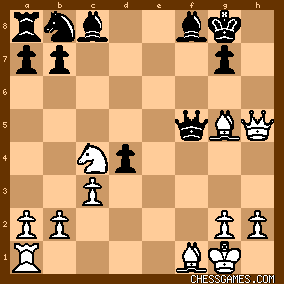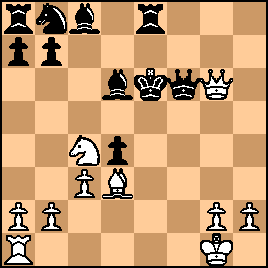| Nov-24-03 | | stinkymagoo: 10...h6 definitely doesn't sit right with me. Was it so late for black that 23...Qxf1 was absolutely necessary? I wonder if there was any other possible way out. |
|
| Nov-24-03 | | Calli: 10...h6 - I think Lasker writes a good note on that move. 23...Qxf1 was best because if the queen moves say 23...Qg4 then 24.Qe8+ wins immediately. |
|
Aug-04-05
 | | chancho: Wow,This game was simply a sacrificial orgy.And to Think Mikhail Tal was not yet born. |
|
| Aug-04-05 | | aw1988: This is a fabulous game. Generally I look at the headline before looking at the game, and seeing Schlechter and Tartakower at their prime promises to me a wonderful clash. |
|
| Aug-04-05 | | Koster: The only way to refute this gambit is to accept it. |
|
| Aug-04-05 | | Boomie: The good doctor's note to move 10 misses a white resource. However I hesitate to post a correction to Lasker. He may have seen a way out of this for black. 10... ♘d7 11. ♘bd2 ♘df6 12. ♘xe4 ♘xe4 13. ♕c2 ♕e7 14. ♖e1 f5 15. ♘g5  (1.30/13) (1.30/13) |
|
| Aug-04-05 | | Boomie: Oddly enough, Uncle Fritz seems to prefer 10...h6! When a tactician as fine as Schlechter makes a defensive move, it usually means it is required. At move 11 black needed to exchange knights.
11...♘xd2 12. ♘xd2 ♕h4 13. ♘f3 ♕h5= (0.09)/13) |
|
Apr-19-06
 | | chancho: Tartakower wrote: <"This game almost, but not quite, received a brilliancy prize; however the squares f7, f6 and h6 on which the initial sacrifices took place, seemed to the judges too familiar and, as it were, lending themselves too easily to the feats accomplished by my troops."> Tartakower's "My Best Games Of Chess 1905-1954"
|
|
| Jul-02-06 | | suenteus po 147: <chancho> Thanks for posting the Tartakower excerpt. I have to get that book...and everything else that Tartakower ever wrote. <chessgames.com> Fun pun! |
|
| Jul-02-06 | | Confuse: tartar sauce yesterday, and today saucy tart? i think i get it.. ? _ ? |
|
| Jul-02-06 | | dakgootje: nice game but it is strange Lasker criticized a move, and says it again at whites 14th, which turned out to be neccessary. but of course, even the famous old worldclass players make mistakes in analysing. |
|
| Jul-02-06 | | kevin86: Here is just another case where a sacrifice is followed by an attack that GAINS material. Good notes by Lasker-good lyrics by Tartakower! |
|
| Apr-21-07 | | Kingsider: 3.Q5h?! |
|
| Apr-16-08 | | Zickzack: Fritz10 has its own vision of things. According to it, 12. ... c5 is the losing move. Bf8 should have been played instead. And 13. ... cd4: aggravates the situation. Here Rf8 should have been tried, e.g.: 14. Nd6: Qd6: 15. Nc4 Qe7 16. dc:. However, White's positional advantage is rated as a won game. Black missed some points in the opening. 9. ... Re8 diverts a defender of f7. Hence, Nf6 is given as better. White missed something, too, namely the unlikely move 8. Nf7:. One lines goes as follows: 8. ... Qe7 9. Nd6: cd: 10. Nd2 Ne4: 11. Bc4+ Be6 12. Be6:+ Qe6: 13. Qe2 d5 14. Ne4: de: 15. Qb5. It looks risky, however. By the way, 19. Bh6: is seen as inferior to 19. Bd3 Qf6 20. Bd2. |
|
| May-15-08 | | notyetagm: White to play: 21 ?

click for larger viewhttp://www.chessvisualization.com/s...
<Chapter 13,<<< EXPANDING THE POSITION>>>, features exercises in which a number of White pieces move up the board in concert, <<<and usually with tempo>>>, in order to create or convert an advantage.363. Tartakower-Schlechter, St. Petersburg, Russia, 1909. 363. 7 Ply. White is up a pawn and can rearrange his pieces on c4 and f1. Visualize the position after the moves 21 Nd6 [1] Bxd6 22 Bc4+ Be6 23 Rf1 Qxf1+ [2] 24 Bxf1. What is the material balance? <<<[1] This move frees c4 for the Bishop, while White's next move frees f1 for the Rook.>>> [2] 23...Qe5 loses to 24 Qe8+ Kh7 25 Bd3+ Bf5 26 Bxf5, when Black has to give up his Queen to avoid mate. > |
|
Feb-01-09
 | | Phony Benoni: <Tartakower wrote: <"This game almost, but not quite, received a brilliancy prize; however the squares f7, f6 and h6 on which the initial sacrifices took place, seemed to the judges too familiar and, as it were, lending themselves too easily to the feats accomplished by my troops."> The irony being that the game which did win the brilliancy prize, Schlechter vs Salwe, 1909, was later found to have a flaw big enough to drive a sleighthrough. |
|
Sep-14-22
 | | Sally Simpson: Tartakower devotes 5½ pages to this game covering psychology, how to class a game of chess as a work of art and what and what is not a banal standard sacrifice. (14.Nxf7) He gives some wonderful variations after 10….h6 ‘The reader who has patiently explored the ramifications of all these variations will find himself rewarded for his pains by the richness of their ornamentation.” The peek into Tartakower’s imagination in one variation ending in a mate on move 28 really is ‘rewarding.’ As Phony Benoni mentioned above this game almost, but not quite, received a brilliancy prize... Another brilliancy prize winner (according to ‘ Chess Brilliancy’ by Iakov Damsky) was played in the very next round and Tartakower was in the receiving end. L Forgacs vs Tartakower, 1909 What is they say; one day you give a lesson, next day you receive one. |
|
| Aug-04-24 | | mel gibson: I saw that sacrifice but I wasn't sure if it was any good. Stockfish 16.1 says:
14. Nxf7
(14. Nxf7 (1.Nxf7 Kxf7 2.Qh5+ Kg8 3.Rxf6 Re1+ 4.Rf1
Bxh2+ 5.Qxh2 Rxf1+ 6.Bxf1 dxc3 7.bxc3 Qf6 8.Qh5 Nc6 9.Qe8+ Qf8 10.Qxf8+
Kxf8 11.Ba3+ Kg8 12.Nd6 Be6 13.Nxb7 Rb8 14.Nd6 a6 ) +5.19/45 268) score for White +5.19 depth 45. |
|
| Aug-04-24 | | mel gibson: When Black resigns it's mate in 14.
Stockfish 16.1
33. .. Rc8
(1. ... Rc8 2.Bf6 a5 3.g5 a4 4.Kf2 a3 5.bxa3 b5 6.Kf3 Rc1 7.Qxf8 Rf1+ 8.Kg2 Kg6
9.Qxg7+ Kf5 10.Kxf1 Ke6 11.Kf2 b4 12.Qb7 bxa3 13.Ke3 Kd6 14.Ke4 Ke6
15.Qe7+) -M14/71 126
White wins _ mate in 14. |
|
Aug-04-24
 | | An Englishman: Good Evening: Too tough. Knowing what the first move must be whilst not knowing how to follow up doesn't count as a solve. Not a great week for me; three already known plus two flubs. Hello, Monday! |
|
| Aug-04-24 | | Cecco: As <Boomie> pointed out exactly 19 years ago, the move criticized by Lasker, 10. ... h6, is considered by the engines to be the best. Black's problems came later, in particular from the maneuver 12. ... c5 and 13. ... cxd4. But as we have seen, predicting White's 14th, even two moves earlier, was insane. |
|
Aug-04-24
 | | NM JRousselle: This is a famous game, so I can't take credit for solving it. |
|
Aug-04-24
 | | chrisowen: I chums its wed q lag o fun rex v jip Nxf7 its achtung much its accord mc ghoul bug its a cuff muff cog its aie its set dub its a gift q i Nxf7 its ear |
|
| Aug-04-24 | | TheaN: Sort of solved this, though I spent considerably less time going through all variations and thus missed some subtleties. Saw <14.Nxf7 Kxf7 15.Qh5+ +-> and had the feeling Black is in all kinds of trouble. I missed 15....Kg8 16.Rxf6! though I probably would have found that over the board: was considering 16.Qg6?! which is still a headache for Black to defend, 16....Nbd7 17.Bxh6 Bf8 18.cxd4 ⩲ to ±, is only a minor advantage to White on paper but terrible to defend in practice. The alternatives to 15....Kg8, which puts the White queen en prise, are a bit easier to solve: 15....g6? 16.Qxg6+ +-, though Qxh6 is almost as destructive. 15....Ke7 or 15....Ke6 16.Qf5+ Ke7 follow 16/17.Qg6! +-, the king blocking the most crucial square for defense. Finally, 15....Kf8 keeps the pin, which means White can safely play 16.Bxh6!, and accepting the second sac is disaster: 16....gxh6 17.Qxh6+ Kf7 18.Qg6+ Ke6 (else Qxf6+) 19.Rxf6+! Qxf6:

click for larger view
White's a rook and piece down, but of course absolutely winning, there are three distinctive lines here that win: 20.Qxe8 #9, 20.Re1+ +5.7 and 20.Bf5+ +5.2 (though the latter obviously includes Re1+ later). Even 20.Qh7? Kd5! ⩱ is just a minor advantage to Black, just to show that material is never the entire story. |
|
| Aug-04-24 | | King.Arthur.Brazil: In the game line: 19...gxh6 20. Qg6+ Bg7 21. Ne5 Qf8 22. Bc4+ Kh8 23. Nf7+ Kg8 24. Ng5+ Kh8 25. Qh7#. I already saw this game (POTD) before. |
|





